Mastering the Art of Pancake Baking: Techniques & Tips
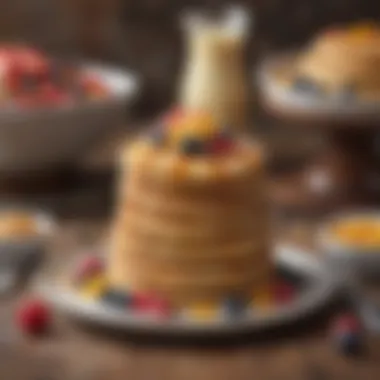
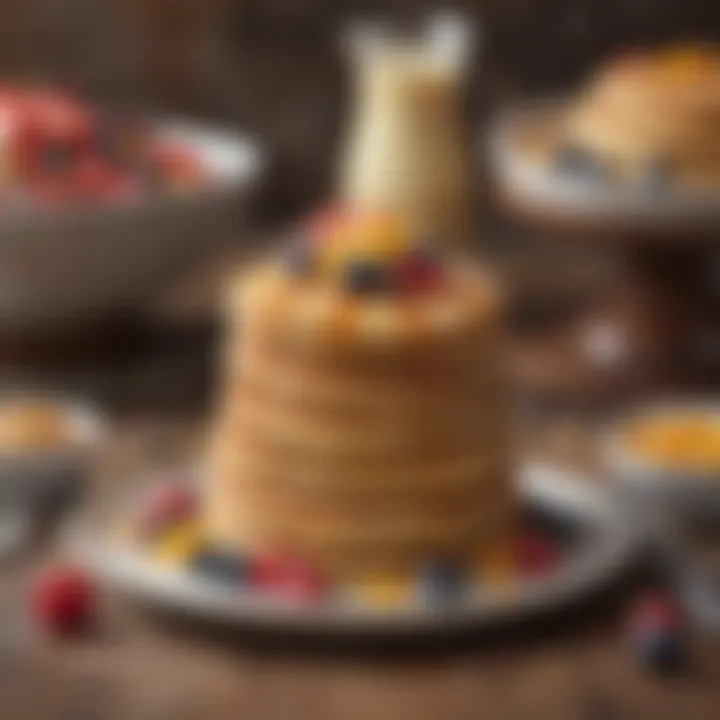
Intro
Pancakes represent a versatile and beloved component of breakfast cuisine across cultures. This article delves into pancake baking—a process more intricate than it may first appear. It is not merely about mixing flour, eggs, and milk; it is about precision, understanding ingredients, and choosing the right techniques to elevate the humble pancake to a culinary highlight. Whether you are a novice starting your culinary journey or a seasoned home cook looking for new variations, this article offers insights. We will discuss the essential ingredients, various preparation methods, and common pitfalls to avoid, aiming to enrich your pancake-making skills significantly.
Recipe Overview
Recipe Name
Classic Fluffy Pancakes
Description of the Dish
Classic Fluffy Pancakes are light, airy, and perfectly golden-brown. They are soft yet firm enough to hold syrup, fruits, or any toppings you desire. This dish serves not just as breakfast but also offers potential for indulgent brunches or even dessert. The simplicity of the ingredients belies the nuances in achieving the ideal texture—crucial for any pancake enthusiast.
Ingredients
List of Ingredients with Measurements
- 1 cup of all-purpose flour
- 2 tablespoons of granulated sugar
- 2 teaspoons of baking powder
- 1/2 teaspoon of salt
- 1 cup of milk (dairy or plant-based)
- 1 large egg
- 2 tablespoons of melted butter (or oil for dairy-free version)
Special Notes on Ingredients
- Substitutions: Whole wheat flour can be used for a healthier option, although it can change the texture slightly. Use non-dairy milk for a vegan alternative.
- Regional Variants: In some cultures, pancakes may incorporate ingredients like cornmeal or buckwheat flour for distinct flavors. Consider experimenting with these variations to broaden your palate.
Tip: Consistently use fresh baking powder. Old leavening agents can result in dense pancakes.
By paying attention to these details, you are better positioned to create a pancake that is not only delicious but also aligns with varying dietary preferences. In the following sections, we will explore preparation techniques, cooking methods, and how to troubleshoot common issues in pancake baking.
Understanding Pancakes
Pancakes are an integral part of many culinary traditions, representing not only a delicious meal but also a convergence of cultural practices and historical significance. Understanding pancakes, therefore, encompasses more than just knowing how to make them; it involves a deeper appreciation of their origins, variations, and significance in different cultures. This article aims to explore the multifaceted nature of pancakes by examining their history and cultural variations while providing practical insights into their preparation and customization.
History of Pancakes
The history of pancakes is vast and stretches back thousands of years. Early records indicate that mankind has been consuming flat cakes made from grains mixed with water and cooked on hot stones or over an open fire since ancient times. A notable early version can be found in ancient Greece, where they prepared a dish called ‘kytios’, made from wheat flour, olive oil, honey, and curd.
In ancient Rome, pancakes were referred to as ‘alia dulcia’, often elaborately flavored and served with various toppings.
Throughout history, pancakes have been adopted and adapted by numerous cultures, each bringing its unique twist and character. This rich history not only enhances our knowledge of pancakes but also informs our understanding of contemporary variations, creating a tapestry that reflects culinary creativity and cultural exchange.
Cultural Variations
Pancakes are not a monolithic dish; instead, they come in various shapes, sizes, and preparations across the globe. Each culture creates its pancake while celebrating its unique culinary traditions. Here are a few popular examples:
American Pancakes
American pancakes are characterized by their fluffy texture, typically made with a leavening agent such as baking powder. The batter is thicker than that of other pancakes, which results in a thicker final product. Often served stacked and accompanied by syrup and butter, these pancakes have become a staple in American breakfasts. Their popularity lies in their ease of preparation and ability to satisfy various palates—whether sweet or savory. The side options such as berries, chocolate chips, or even nuts add versatility. However, the thick nature may not appeal to those seeking a lighter option.
French Crêpes
Crêpes, hailing from France, offer a more refined take on pancakes. They are made from a thin batter of flour, eggs, and milk, resulting in a delicate and versatile dish. Crêpes can be prepared either as sweet or savory, making them ideal for any meal, including breakfast, lunch, or dinner. Their key characteristic is the thinness, which allows for various fillings ranging from Nutella to ham and cheese. The ability to customize crêpes presents an exciting option but may require more finesse in preparation compared to thicker pancakes, making them less appealing to novice cooks.
Japanese Pancakes
Japanese pancakes, also known as soufflé pancakes, are renowned for their ethereal lightness and fluffiness. Made with egg whites whipped into peaks, the result is a product that is airy and delectable. Their unique feature lies in their high-rise nature, creating a visually impressive stack. These pancakes are typically served with syrup or fruits and present an advantage for those looking for a lighter treat. However, crafting the perfect soufflé pancake requires precision and technique, which may be a challenge for some.
Russian Blini
Blini are traditional Russian pancakes, often made with buckwheat flour, providing a distinct flavor. Frequently served during Maslenitsa, a festival marking the end of winter, blini are typically served with sour cream and caviar. They are notable for their key characteristic of being both light and filling, offering a unique palate experience. The usage of buckwheat flour in blini highlights the cultural significance, capable of catering to diverse dietary preferences. However, those unfamiliar with buckwheat may find the flavor somewhat strong.
By understanding these cultural variations, one gains insight into not just how pancakes are made, but also how they can reflect the culinary customs and regional flavors of various societies. This understanding enriches the overall pancake experience, making it not only a dish but a story of human creativity and adaptation.
Essential Ingredients
Understanding the role of essential ingredients is crucial for mastering pancake baking. Each component contributes uniquely to the overall texture, flavor, and nutritional profile of pancakes. Selecting high-quality ingredients significantly enhances the final product, making pancakes fluffy and flavorful.
Flours and Their Types
All-Purpose Flour
All-purpose flour is a versatile choice for pancake batter. Its moderate protein content offers a balance between texture and structure. It allows pancakes to rise properly while remaining tender. This flour is widely available and works well in most pancake recipes, making it a popular option among home cooks. A key characteristic of all-purpose flour is its consistency, which ensures uniform results. However, it may produce slightly less flavor compared to specialty flours.
Whole Wheat Flour
Whole wheat flour brings a nutty flavor and added nutrition to pancakes. This flour retains the bran and germ, making it richer in fiber and essential nutrients. It is a beneficial choice for those seeking healthier options. The use of whole wheat flour can lead to denser pancakes, but many find the flavor enhancement worthwhile. The unique features include a higher protein content, which may result in a heartier pancake. Consider combining it with all-purpose flour to balance texture and nutrition.

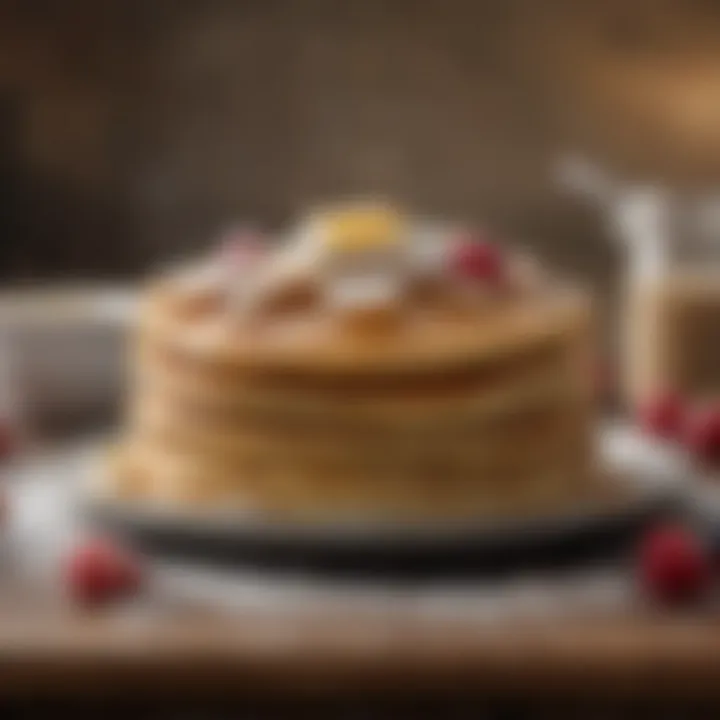
Buttermilk Pancakes
Buttermilk is a traditional ingredient that adds richness and tanginess to pancakes. Using it in batter creates pancakes that are moist with a tender crumb. This ingredient helps activate baking soda, ensuring a good rise. The unique feature of buttermilk pancakes is their fluffy yet flavorful nature. While buttermilk might be less accessible to some, its contribution to taste and texture is notable. Substituting regular milk with buttermilk is an effective means to elevate the overall pancake experience.
Leavening Agents
Baking Powder
Baking powder is a critical leavening agent that provides lift and fluffiness in pancakes. It contains both an acid and a base, which react when wet and heated. Baking powder is a reliable choice for recipes requiring a quick rise, making it essential for creating light, airy pancakes. Its key characteristic is its double-acting nature, which allows for bubbles to form at room temperature and again when heated. It is convenient since there is no need to add additional acids like vinegar or lemon juice. However, using too much can lead to a bitter taste in the pancakes.
Baking Soda
Baking soda is used to spatialize the batter, creating bubbles that result in nicely risen pancakes. It requires an acidic ingredient to be effective, such as buttermilk or yogurt. This leavening agent’s key characteristic is its ability to work rapidly, making it ideal for pancake recipes that cook quickly. The unique advantage of baking soda is its effectiveness in producing a tender texture. However, caution is needed as excess can result in a metallic taste and overly dark pancakes.
Liquid Components
Milk
Milk forms the base of pancake batters, offering moisture and aiding in the blending of dry ingredients. Its key characteristic is the fat content, which contributes to a rich flavor. Whole milk creates a creamier texture, while skim milk yields thinner pancakes. The unique feature of milk lies in its ability to enhance the batter's overall fluidity. While almost any milk can be used, experimentation with different types can lead to varied textures.
Non-Dairy Alternatives
Non-dairy alternatives have gained popularity due to dietary preferences and restrictions. Options like almond milk, soy milk, or oat milk provide similar moisture levels to cow's milk while catering to those avoiding animal products. A key characteristic is their versatility, allowing customization of flavors. Non-dairy alternatives tend to result in pancakes that are slightly different in taste and texture. However, it is essential to choose variations that are unsweetened to avoid overpowering the batter.
Water
Water may seem simple, but it plays an important role in pancake preparation. It helps to hydrate the dry ingredients, ensuring even mixing. While it's not as flavorful as milk, it can be an effective choice for low-calorie pancakes. The key characteristic of using water is its neutrality, which won’t interfere with other flavors. However, pancakes made solely with water may lack the richness expected from traditional recipes.
Flavoring and Sweetening Agents
Vanilla Extract
Vanilla extract is often added to pancake batters for its ability to enhance flavor. Its key characteristic lies in the complex notes of sweetness and warmth it brings to the dish. Vanilla is a popular choice because it complements both sweet and savory pancake variations. The unique feature is its capability to elevate the overall taste profile, turning an ordinary pancake into something special. However, using too much can lead to an overpowering flavor.
Maple Syrup
Maple syrup is a classic sweetener for pancakes, known for its unique, rich flavor. Its key characteristic is its natural sweetness and signature taste, which pairs well with the pancakes. This syrup is often preferred over artificial syrups because it offers greater depth and authenticity. The remarkable feature of maple syrup is its ability to caramelize slightly when heated, enhancing the overall flavor. However, it is calorie-dense, so moderation is key.
Cocoa Powder
Cocoa powder adds a rich chocolate flavor to pancake recipes. As a flavoring agent, its key characteristic is that it can create delightful variations, appealing to chocolate lovers. Cocoa powder is versatile; it can easily be combined with other flavors. An important feature is that it contributes to a darker color and enticing aroma. However, care should be taken not to add too much, as it can overpower the delicate pancake flavor.
Pancake Preparation Techniques
Understanding the nuances of pancake preparation techniques is essential to achieving the perfect pancake. The methods you choose during the preparation stage can significantly dictate the texture, flavor, and overall success of your pancakes. This section emphasizes how these preparation techniques lay the groundwork for a satisfying culinary experience.
Mixing of the batter is a fundamental step that requires attention to detail. Many people might not realize that the order of combining wet and dry ingredients can influence the final product. The resting period after mixing is another critical aspect as it enables the batter to mature, impacting the texture. By mastering these techniques, pancake baking can transition from a mundane task to an engaging experience.
Mixing the Batter
Dry vs. Wet Ingredients
A clear distinction exists between dry and wet ingredients in the context of pancake batter. Dry ingredients typically include various flours, sugars, and leavening agents, while wet ingredients encompass milk, eggs, and oils. Mixing these two categories in the correct manner is essential to achieve the desired pancake consistency.
The key characteristic of combining dry and wet ingredients is that it sets the foundation for a balanced batter. This is a popular choice in pancake preparation, as it allows for even distribution of flavor and texture. The unique feature is that dry ingredients need to be sifted to avoid clumps, which ensures a smooth batter. While a beneficial process, it can become a disadvantage if one is not careful, leading to overmixing or improper texture.
Avoiding Overmixing
Overmixing batter is a prevalent mistake that can undermine your pancake-making efforts. Pancake batter flour is high in gluten, and excessive mixing results in a rubbery texture instead of the desired fluffiness. Thus, understanding the right mixing technique is vital for success.
The key characteristic of avoiding overmixing is that it preserves the pancakes' light and airy nature. It’s a beneficial practice, especially in achieving optimal texture, ensuring that the finished product remains fluffy.
The unique feature of this aspect is that just a few lumps can be acceptable. It’s a fine balance; undermixing can also lead to inadequate blending of the flavors, affecting taste. The consideration here involves practicing restraint; knowing when to stop is crucial.
Resting Period Importance
Impact on Texture
The resting period after mixing pancake batter is a crucial element that impacts texture significantly. Allowing the batter to rest for about 15-30 minutes enables the flour to absorb moisture and the gluten strands to relax.
This key characteristic is vital for producing light and airy pancakes. It’s a beneficial step because it enhances the overall mouthfeel. The unique feature of this resting period is that it gives the batter a chance to develop, leading to improved texture and reduced toughness.
Gluten Development
Understanding gluten development can elevate pancake-making skills. When flour is mixed with liquid, gluten begins to form, giving structure to the pancakes. Moderation is key; too much mixing can lead to a dense pancake, whereas the right amount can amplify its structure.
The key characteristic of gluten development is that it allows for flexibility in baking. It’s a crucial element in creating pancakes that hold their shape while remaining tender. The unique feature lies in how gluten contributes to the final pancake. A well-balanced gluten development ensures that the pancakes do not become overly tough or chewy, maintaining a desirable fluffy profile.
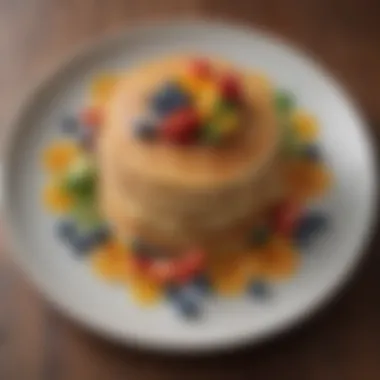
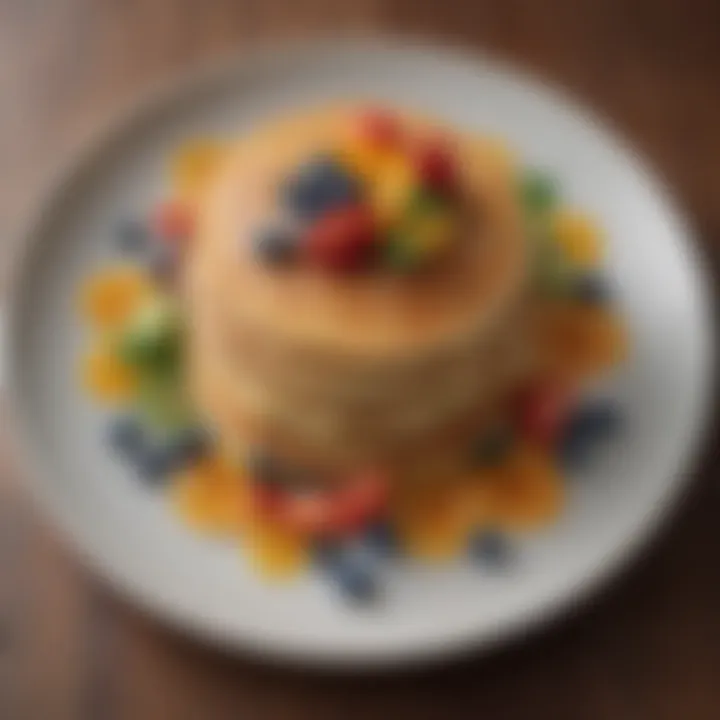
Cooking Pancakes
Cooking pancakes is a fundamental skill that serves as the bridge between a prepared batter and a delightful dish. The process not only influences the aesthetic appeal of the pancake but also its texture and flavor. Understanding the importance of cooking techniques ensures every pancake is evenly cooked, fluffy, and pleasing to the palate. Factors such as the cooking surface and heat levels play crucial roles in this phase, impacting the overall outcome.
Optimal Cooking Surface
Non-Stick Pans
Non-stick pans are favored for cooking pancakes due to their unique coating that prevents food from sticking. This characteristic simplifies the cooking process, allowing for easy release of pancakes once they are ready to flip. Furthermore, non-stick pans typically do not require excessive amounts of oil or butter, making them a healthier option. However, it is important to use non-metal utensils to avoid damaging the coating. A disadvantage is that non-stick pans can wear out over time, leading to reduced effectiveness.
Cast Iron Skillets
Cast iron skillets are another popular choice for pancake cooking. The heat retention of cast iron provides even cooking, leading to a uniform brown color on the pancakes. A key characteristic of cast iron is its ability to develop a natural non-stick surface when seasoned properly. This feature offers a rustic approach to cooking, which many find appealing. However, cast iron skillets can be heavy and require maintenance to prevent rusting, which some users might find cumbersome.
Heat Levels and Timing
Medium Heat Guidelines
Medium heat is crucial in pancake cooking to ensure they cook through without burning. This heat level allows for a balance between browning the surface while ensuring the inside cooks evenly. Following medium heat guidelines helps maintain control over the cooking process, which is essential in achieving the perfect pancake. A disadvantage is that inexperienced cooks might find it challenging to judge when to adjust the heat based on their particular stovetop performance.
Flipping Techniques
Flipping techniques are essential to moving pancakes from pan to plate without losing form. A key characteristic of effective flipping involves timing, knowing when the bubbles on the surface indicate readiness for a turn. Using a spatula correctly contributes to a smoother flip. Proper flipping maintains the pancake's shape and prevents tearing, ensuring that the ideal texture is retained. While it may seem trivial, mastering flipping techniques greatly enhances the cooking experience and end-result.
Common Mistakes in Pancake Baking
Baking pancakes may seem simple, but many factors can lead to unsatisfactory results. Understanding common mistakes enhances the experience. This section addresses significant mishaps that can occur during the baking process. By identifying and avoiding these errors, one can achieve the perfect pancake. Mistakes not only affect the final taste and texture but also the overall enjoyment of the dish.
Overmixing the Batter
One of the frequent mistakes in pancake making is overmixing the batter. Many cooks believe that mixing thoroughly will yield a smoother texture. However, this perception leads to gluten development. Gluten makes pancakes tough, rather than light and fluffy.
Key Points:
- Mix until ingredients are just combined.
- Small lumps in the batter are acceptable.
- Allow resting time for better texture.
To avoid overmixing, consider using a gentle folding method. Incorporate ingredients slowly. This practice helps maintain the batter's integrity. Remember, pancakes are meant to be soft and airy.
Incorrect Heat Settings
Another crucial element in pancake baking is the heat settings. Mistakes in this area can lead to uneven cooking. Too high heat can result in burnt exteriors and raw interiors. Conversely, low heat might lead to rubbery pancakes. Finding the right balance is essential.
Tips for Managing Heat:
- Preheat pans on medium heat.
- Use the water droplet test for readiness.
- Adjust heat based on performance.
Start with a moderate heat setting, and adjust as needed. Keep an eye on the pancakes. Brown edges and bubbles indicate it is time to flip.
Underestimating Ingredient Quality
The third common mistake relates to ingredient quality. Often, cooks overlook how essential fresh, quality ingredients are for flavor. Using expired or low-quality products can significantly alter the pancakes. Flour, eggs, and milk should be fresh for optimal taste.
Considerations:
- Check expiration dates on flour and dairy.
- Choose organic or high-quality ingredients when possible.
- Always select fresh fruits or flavors for variety.
Investing in quality ingredients enhances the overall pancake experience. Take time to select the best available options, as taste is directly impacted.
Remember, avoiding these common mistakes can lead to extraordinary pancake results. Focus on technique and ingredient selection for the best outcomes.
Variations and Customizations
In the world of pancake baking, variations and customizations play a significant role in making the experience both satisfying and enjoyable for diverse tastes. Including different ingredients allows for the adaptation of pancakes to cater to various dietary preferences and flavor profiles. As people become increasingly conscious of health, dietary restrictions, and personal preferences, understanding these variations becomes essential for any avid pancake enthusiast. Customization not only broadens the appeal of pancakes but also provides an opportunity for creativity and experimentation in the kitchen.
Healthy Pancake Options
Whole Grain Pancakes
Whole grain pancakes are an excellent alternative to traditional pancakes made from refined flour. They contribute significantly to a healthier diet due to their higher fiber content. This characteristic makes them filling and aids in digestion. By using whole wheat flour or a blend of whole grains, these pancakes offer a nuttier flavor and denser texture compared to their white flour counterparts.
The unique feature of whole grain pancakes is their ability to retain essential nutrients that can be lost in processing. For individuals seeking to incorporate more whole grains into their diet, this option stands out as beneficial. However, a potential downside is that the density of whole grain pancakes can be off-putting for those accustomed to lighter, fluffier pancakes.
Gluten-Free Alternatives
For many individuals, gluten is a concern due to dietary restrictions or allergies. Gluten-free pancakes have become popular for those needing alternatives that avoid this protein. Common gluten-free flours include almond flour, rice flour, and oat flour, which can provide exciting flavors while ensuring safety for those with gluten intolerances.

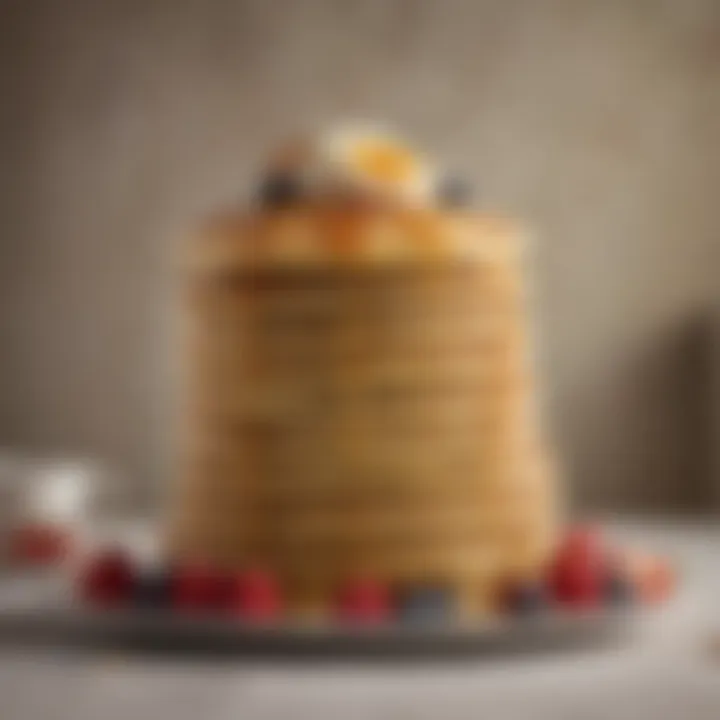
The key characteristic of gluten-free alternatives is their versatility. Many recipes allow for creativity in choosing which flour to use, paired with additional ingredients for flavor. The unique feature of these pancakes often lies in their texture, which can vary significantly based on the type of flour used. Although gluten-free pancakes can be softer or crumblier than traditional pancakes, with the right recipe, they can be both delicious and satisfying.
Flavor Enhancements
Fruit Additions
Adding fruits to pancake batter not only enhances the flavor but also increases nutrition. Common fruits such as blueberries, bananas, or diced apples can infuse pancakes with moisture and a sweet taste. This aspect makes fruit additions an appealing choice when aiming for a balance between indulgence and health.
The unique feature of fruit-enhanced pancakes is their natural sweetness, which can reduce the need for additional sugar. However, it is important to consider that more moisture from fruits can alter the texture of the pancake, so adjusting cooking times and ingredient ratios may be necessary.
Spices and Herbs
Incorporating spices and herbs into pancake batter introduces a dimension of flavor that can transform the dish entirely. Cinnamon, nutmeg, or even herbs like rosemary can elevate the pancake experience. Spices not only add warmth and depth but also offer potential health benefits, such as anti-inflammatory properties.
The distinguishing characteristic of pancakes with spices or herbs lies in their fragrant aroma and complex flavors. This option is beneficial for those seeking to break away from traditional sweet pancakes. However, the challenge often lies in balancing flavors; too much spice can overwhelm the dish, making experimentation essential for the right mix.
The art of pancake baking is not only in mastering the batter but also in exploring the myriad ways to adapt and customize to personal tastes.
Serving Suggestions
Serving suggestions play a crucial role in elevating the pancake experience. Each option enhances the flavor profile and adds visual appeal to the dish. These suggestions can transform a simple pancake stack into a delightful meal or a festive treat. As you explore these ideas, consider how each ingredient complements the texture and taste of the pancakes themselves. Paying attention to these details ensures that both presentation and flavor are optimal, catering to varied palates and dietary preferences.
Classic Toppings
Butter and Syrup
Butter and syrup are quintessential pancake toppings. Their combination provides rich creaminess and sweetness. When slathered on warm pancakes, butter melts into a luscious pool. Maple syrup follows, bringing its distinctive character. The unique feature of this pairing is its balance of flavor and texture. This combination results in a comforting experience that's hard to resist. Moreover, using quality butter and pure maple syrup can significantly enhance the overall taste. However, one can consider the caloric content; the richness might not suit all dietary needs.
Fresh Fruits
Fresh fruits add color, freshness, and nutrition to pancakes. Berries, bananas, and apples are popular choices. They introduce natural sweetness and acidity, which balance the carb-laden pancakes. Each fruit has unique characteristics that can transform a dish. For example, strawberries provide juiciness while blueberries burst with flavor. Also, adding sliced bananas adds creamy texture. These options are beneficial as they can contribute vitamins and fiber. A downside can be seasonal availability; not all fruits are fresh year-round.
Savory Pancake Options
Cheese and Vegetables
Integrating cheese and vegetables into pancakes creates a new culinary dimension. This combination enhances the dish by adding umami flavors and nutritional value. Ingredients like spinach, bell peppers, or cheddar can create a savory delight. One key characteristic of this option is versatility; they can be served as a meal for breakfast or lunch. Cheese melts into a creamy texture while vegetables offer refreshing crunch. The downside may include the need for careful balance in flavor; too much cheese could overpower the pancake itself.
Herbed Variants
Herbed variants introduce an aromatic element to pancakes. Fresh herbs like chives, parsley, or dill can significantly transform the flavor profile. These ingredients are beneficial as they offer freshness and enhance the dish without adding calories. The unique feature of herbed pancakes is their adaptability. They can serve as a side dish or a main attraction, complementing dishes like grilled meats or soups. However, the challenge lies in ensuring the herbs are finely chopped to avoid textural issues when eating.
A balanced approach in crafting pancakes hinges on the right toppings and fillings. Paying attention to each component can lead to delightful variations that please any palate.
Exploring Global Pancake Recipes
Exploring global pancake recipes enriches the understanding of this beloved dish. Each culture presents its unique variations, reflecting local ingredients and traditions. This section aims to highlight some signature styles: the American stack, the delicate French crêpe, and the Korean hotteok. By doing so, readers gain insight into the versatility of pancakes, elevating their culinary repertoire.
American Stack
The American pancake stack is iconic for its fluffy texture and thick round shapes. Typically made with all-purpose flour, baking powder, eggs, milk, and sugar, these pancakes are often served in a towering stack. They commonly feature maple syrup and butter, which create a sweet and rich experience. The pancake’s density allows for interesting toppings like whipped cream, berries, or even chocolate chips. A notable detail is the balance between the batter's thickness and its cooking time on a medium-heat surface.
"American pancakes are not just a breakfast staple, they deliver comfort and satisfaction with every bite."
French Crêpe Revival
French crêpes offer a different flavor profile and texture. These thin pancakes are made from a batter of flour, eggs, and milk, yielding a delicate and flexible result. Traditionally enjoyed with sugar and lemon or filled with a variety of ingredients like Nutella or ham, crêpes can shift from sweet to savory. Their versatility lends them to both casual snacks and gourmet desserts, allowing for extensive experimentation in fillings. The emphasis in crêpe-making is on the technique of spreading the batter thinly and evenly in a hot skillet.
Korean Hotteok
Korean hotteok presents a delightful contrast to its Western counterparts. These pancakes are typically made from a yeast dough filled with a mixture of brown sugar, cinnamon, and chopped nuts. Upon frying, the hotteok becomes crispy on the outside while the inside melts delightfully. This adds a warm sweetness that blends well with the dough. Hotteok is often enjoyed as a street food item in Korea, making it a portable option for on-the-go snacking. The unique filling sets this pancake apart, emphasizing the diverse cultural perspectives on this universal dish.
In summary, global pancake variations demonstrate how regional preferences shape culinary practices. Understanding these differences can inspire individuals to create pancakes that resonate with personal tastes while broadening their palates.
Epilogue
The conclusion of this article emphasizes the significance of mastering pancake baking, an art that transcends mere cooking. Pancakes represent a versatile and beloved dish that can cater to a wide range of tastes and preferences. Throughout this article, we explored various essential ingredients, preparation techniques, and cooking methods that contribute to creating the perfect pancake.
Key Elements to Remember
In the realm of pancake baking, precision is paramount. Understanding the balance between your ingredients—such as the type of flour or the leavening agents—can drastically affect your final product. For instance, using whole wheat flour introduces a different texture and flavor compared to all-purpose flour. This knowledge aids in personalizing your pancakes to suit your dietary needs and taste preferences.
Benefits of Strong Foundations
Having a solid grasp of pancake preparation techniques, such as the importance of resting the batter or not overmixing, enhances overall results. These practices lead to pancakes that are both light and fluffy, showcasing the best of what this dish can offer. Moreover, recognizing and avoiding common mistakes—like incorrect heat settings or ingredient quality—ensures an elevated baking experience.
Considerations for the Modern Cook
In today's culinary landscape, pancakes have evolved beyond traditional recipes. The exploration of global variations allows for creativity in the kitchen. Adapting pancake recipes, whether to accommodate gluten-free diets or to enhance flavors with spices, reflects a modern understanding of food.
"Mastery of pancake baking fosters confidence in the kitchen, encouraging experimentation and innovation."







